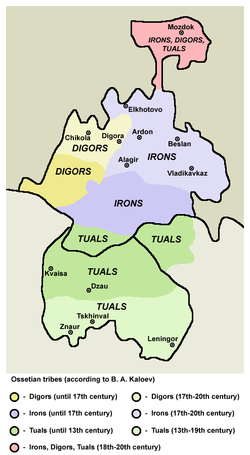| Digorænttæ | |
|---|---|
 Ossetian flag Ossetian flag | |
| Total population | |
| ~200,000 | |
| Regions with significant populations | |
| est. 100,000 | |
| unknown | |
| 700 (2013) | |
| Languages | |
| West Ossetian | |
| Religion | |
| Majority: Minority: | |
| Related ethnic groups | |
| other Iranian peoples, Balkars | |
| |

The Digor or West Ossetians (Ossetian: Дигорæнттæ, romanized: Digorænttæ, pronounced [digɔːrɐ, digɔːrɐnttɐ]) are a subgroup of the Ossetians (Alans). They speak the Digor dialect of the Eastern Iranian Ossetian language, which in USSR was considered a separate language until 1937. Starting from 1932 it is considered just a dialect of Ossetian language. The speakers of the other dialect - Iron (East Ossetian) - do not understand Digor (West Ossetian), although the Digor usually understand East Ossetian, as it was the official language of the Ossetian people and officially taught in schools. In the 2002 Russian Census 607 Digors were registered, but in the 2010 Russian Census their number was only 223. It was estimated that there are 100,000 speakers of the dialect, most of whom declared themselves Ossetians. The Digor mainly live in Digorsky, Irafsky, Mozdoksky districts and Vladikavkaz, North Ossetia–Alania, also in Kabardino-Balkaria, Turkey and Syria.
Etymology
Scholars generally link the root dig- with the Circassian endonym A-dyg-e, where the suffix -or could be a mark of plurality as found in many contemporary Caucasian languages. This point of view was criticized by R. Bielmeier and D. Bekoev, they raised the ethnonym to "tygwyr" in the Iron dialect, meaning "gathering, gathering, group."
History
Middle Ages
The early medieval Ashkharatsuyts makes mention of the "nation of the Ash-Tigor Alans" (azg Alanac' Aš-Tigor), or simply the "Dikor nation" (Dik'ori-n), which is generally regarded as an early reference to the Digor. This fact, and other linguistic considerations, have led scholars to believe that Digor dialect became separated from Proto-Ossetian during the Mongol conquests.
Genocide of 1944
During World War II, North Ossetia–Alania was occupied by German armies in 1942. After the Germans were forced out of the region, the Muslim Digors, like other Muslim peoples, were accused of Collaboration with the Germans and deported to Central Asia. Estimates say 50% of the Digors died during deportation. Their reputation was rehabilitated in the mid-1950s, and they were allowed to return to their homelands.
Religion
Most Digors are Muslim. They were converted to Sunni Islam around the 17–18th centuries, under the influence of the neighboring Kabarday people who introduced Islam to them. Starting from the 18th century, the ethnonym digor became widely used by travelers and in Russian official documents. Digoria was annexed to the Russian Empire quite late compared to the rest of Ossetia. In the second half of the 19th century, large numbers of Muslim Digors emigrated to the Ottoman Empire.
Demographics
Digors make the majority of the Ossetians in Digoria, the western part of the North Ossetia–Alania (Digorsky and Irafsky districts), and in Kabardino-Balkaria. In the beginning of the 19th century some families from Digoria resettled in Mozdoksky District, where they reside in the settlements of Novo-Osetinskaya and Chernoyarskaya.
See also
Sources
- Wixman. The Peoples of the USSR, p. 58
References
- "First Ethnic Ossetian Refugees from Syria Arrive in North Ossetia". Jamestown. Retrieved 2022-10-16.
- ^ Minahan, James (2012). Miniature Empires: A Historical Dictionary of the Newly Independent States. New-York: Routledge. p. 211. ISBN 978-1-57958-133-6.
- "Ossetian Digorians. The mystery of the origin of iriston, digoras and the great tamerlane".
- "Archived copy". Archived from the original on 2017-02-05. Retrieved 2017-02-04.
{{cite web}}: CS1 maint: archived copy as title (link) - http://s50.radikal.ru/i129/1003/22/2fec9d793e3d.jpg
- Камболов, Тамерлан Таймуразович (2006). Очерк истории осетинского языка. Владикавказ: Ир. p. 410.(in Russian)
- "Russian Census 2002: Population by ethnicity" (in Russian). Archived from the original on 29 February 2016. Retrieved 19 April 2014.
- "Russian Census 2010: Population by ethnicity" (PDF) (in Russian). Retrieved 19 April 2014.
- "Digor in Russia". Joshua Project. Retrieved 17 May 2014.
- ^ Абаев, Василий И. (1958). Историко-этимологический словарь осетинского языка. Том I (А-К) (in Russian). Москва - Ленинград: Издательство Академии наук СССР. pp. 379–380.
- ^ Alemany, Agustí (2000). Sources on the Alans: A Critical Compilation. Brill. p. 10. ISBN 978-90-04-11442-5.
- ^ Olson, James S., ed. (1994). An Ethnohistorical Dictionary of the Russian and Soviet Empires. Westport: Greenwood Press. p. 200. ISBN 0-313-27497-5.
- Minahan, James (2002). Encyclopedia of the Stateless Nations: Ethnic and National Groups Around the World. Vol. III (L-R). Westport: Greenwood Press. p. 1478. ISBN 0-313-32111-6.
- "Ossetian Digorians. The mystery of the origin of iriston, digoras and the great tamerlane".
| Ethnic groups in the Caucasus | ||||||||||||||||||
|---|---|---|---|---|---|---|---|---|---|---|---|---|---|---|---|---|---|---|
| Caucasian (areal) |
|  | ||||||||||||||||
| Indo- European |
| |||||||||||||||||
| Turkic |
| |||||||||||||||||
| Others | ||||||||||||||||||